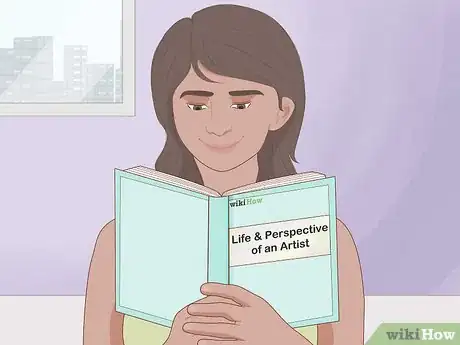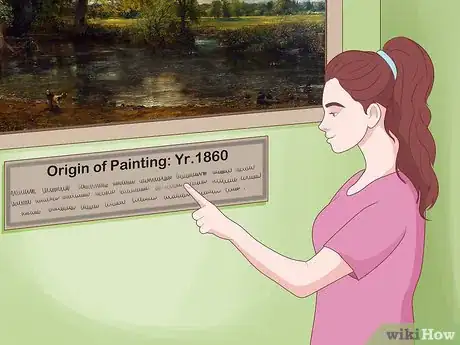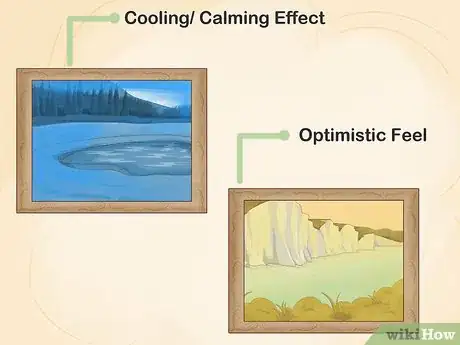This article was co-authored by Kelly Medford. Kelly Medford is an American painter based in Rome, Italy. She studied classical painting, drawing and printmaking both in the U.S. and in Italy. She works primarily en plein air on the streets of Rome, and also travels for private international collectors on commission. She founded Sketching Rome Tours in 2012 where she teaches sketchbook journaling to visitors of Rome. Kelly is a graduate of the Florence Academy of Art.
There are 23 references cited in this article, which can be found at the bottom of the page.
This article has been viewed 61,640 times.
Art can often seem inaccessible because it has been stereotyped in popular culture as something that only particularly educated or wealthy people can enjoy. However, this couldn’t be further from the truth! Anyone can come to appreciate art with a little bit of time and effort. Learning about the context around a work of art, understanding the craft, and using your imagination to bring your own interpretation to art can help you enjoy it more![1]
Steps
Understanding the Artist and their Context
-
1Understand the historical context of the time when the art was produced. Artists often create works to comment on major historical events, and this can give you a window into their unique perspective.[2] In contrast, powerful institutions and people throughout history often commissioned artists to create pieces that endorsed their agendas. This affects the intended audience of the art piece — who was meant to see the art.[3]
- For example, Pablo Picasso’s Guernica (1937) was created in response to the bombings during the Spanish Civil War. It’s filled with anti-war symbolism.[4] Picasso said of the artwork: “Painting is not done to decorate apartments. It is an instrument of war against brutality and darkness.”
- During the Renaissance, the Roman Catholic Church relied a lot on commissioned art as a means of promoting their cause and asserting their power.
-
2Find out the genre of the painting. If you’re looking at a painting, knowing what genre it belongs to can be helpful. Genres are essentially categories that are used to classify art. In painting, the established and well-known genres are landscape, portraiture, genre paintings (which are paintings of scenes from ordinary life), history, and still life.[5]
- John Constable’s The Hay Wain (1821) is a famous Landscape painting that led to the resurgence of landscape painting in the 19th century.[6]
- Girl with a Pearl Earring (1665) by Johannes Vermeer is considered to be a masterpiece of portraiture.[7]
- Judith Leyster’s Carousing Couple (1630) is a great example of a genre painting.[8]
- History paintings depict a moment in a specific historical narrative. Vasily Surikov’s The Morning of the Streltsy Execution (1881) is a very intricate history painting example.[9]
- Lastly, still life paintings are of inanimate, commonplace objects. Van Gogh’s Sunflowers (1889) is a bright and sunny still life example.[10]
Advertisement -
3Learn about the art movements or schools that influenced the piece. Art movements were surges in popularity of certain ways of creating art. An art “school” is basically just a group of artists, sometimes all in the same region, who all have a similar style or subject matter. Knowing a little bit about these can help you understand why an artist might have made certain choices.
- For example, painters in the Egyptian school of art had certain rules that they had to follow — like the size of any figure they drew was supposed to vary based on the social status of the person they were painting. They also couldn’t use more than six colors, and each color symbolized a different aspect of life or death.
- Impressionism, one of the largest 19th-century art movements, is defined by short, loose brushstrokes that are intended to capture the quality of light.[11]
-
4Read up on the life and perspective of the artist. Learning a bit about the artist who created a piece can help shed light on it in a variety of ways.[12] It can help you understand why they made certain artistic decisions, or chose to make the work at all in the first place.[13]
- For example, Mexican painter Frida Kahlo had limited mobility after fighting off polio and enduring a bus accident in her early life. Her pain and struggle manifests in several of her pieces.[14]
Recognizing an Artist’s Craft
-
1Learn when the piece was produced. Art museums typically have informational plaques next to each work that will provide basic information about the piece. Knowing when a piece of artwork was created can help you appreciate the difficulty involved in making it.
- For instance, landscape paintings produced before the rise of photography (which began to include landscapes around 1860) were definitely more challenging to do![15]
-
2Identify the medium that was used to make the art. A medium refers to the material used to create a piece of art. The type of material used affects how the artist made the piece. If you can’t tell which medium was used, museums or galleries will often state the medium of an artwork on informational plaques.
- Oil and acrylic paints are examples of media for painters, while bronze and marble are media for sculptors.
- With the rise of modern art, media has expanded to include not just types of paint and stone, but also materials like found/appropriated objects or even bodily excretions. This has led to the creation of the term “mixed-media,” which is used when talking about an art piece made from a variety of materials.[16]
-
3Recognize the artist’s effort to convey lines. For visual works, notice the artist’s ability to create confident lines. Lines are created when an artist draws or paints marks on a page, when a sculptor bends or shapes material, or when a photographer angles their camera a certain way. Some ways to describe lines are dashed, bold, rough, smooth, or implied.[17]
-
4Pay attention to the shapes that stand out in the painting. Note any interesting shapes that grab your eye when you look at a piece of art and think about how the artist achieved them. Shapes can be geometric or organic.
- Geometric shapes are simple, commonly-recognized shapes like squares or rectangles. Organic shapes are unique and free-form.
- Looking at still life paintings of fruit is a great way to understand how artists have experimented with shape.[18]
-
5Notice how the artist uses color. Ask yourself why the artist chose to use the combination of colors that they did and if these colors work in harmony or contrast. Color has an enormous effect on how we feel when we look at a piece.
- For example, pieces with blue undertones are known to have a calming effect on the viewer. Meanwhile, yellow is associated with light and feelings of optimism.[19]
-
6Study the brushwork of a painted piece. Brushwork, or the way that the artist applied paint using their brush, really sticks out when you are looking at paintings in-person. It’s used to create certain effects in the art, contributing to both texture and mood.
- For example, the feathery, light brushwork in Impressionist paintings is intended to mimic the qualities of light.
- Harsh and erratic brush strokes can communicate a sense of tension and anxiety in a piece.[20]
Making Meaning out of Art
-
1
-
2Evaluate how a work of art makes you feel. Be in touch with your own emotions as you view art. Do you feel excited? Calm? Anxious? Confused? Art can evoke a wide range of emotional responses, so do your best to be conscious of yours.[23]
-
3Offer your own interpretation of what the art means. Part of the fun of viewing art is that you get to come up with your own story about it! Art is very subjective, so even if your interpretation of a piece isn’t exactly what the artist intended, it’s okay! There is often not just one right answer. What’s important is that you make a genuine effort to extract meaning from their work.[24]
- Because every person has a different set of unique experiences, it’s valid for every person who views a piece of art to walk away with a different understanding of it. This can lead to interesting discussions! Ask the person next to you what they think.[25]
- It’s also completely fine to offer no interpretation at all, and instead just enjoy the art for its physical properties.[26]
-
4Applaud the ambiguity of abstraction. Abstract art — art that doesn’t look like anything in the real world — can be a little harder to appreciate because the message or emotion that the artist is trying to convey is not always immediately clear. To enjoy abstract art, think about what grabs your eye first in the piece, and why the artist might have wanted your attention to go there.
- Abstract art can be fun because it’s like a puzzle. You really have to give it some thought to come up with a potential meaning for it. Remember, your meaning doesn’t have to be necessarily correct!
-
5Learn what you like and don’t like. As you view more and more art, you will start to develop an understanding of what you like and dislike in a piece of art. This can help you seek out similar artists.
- You don’t have to love everything that you see! Artist statements or descriptive brochures can sometimes be misleading, so if you unexpectedly don’t like a certain type of art, that’s fine.[27]
Expert Q&A
-
QuestionHow do you critique a work of art?
 Kelly MedfordKelly Medford is an American painter based in Rome, Italy. She studied classical painting, drawing and printmaking both in the U.S. and in Italy. She works primarily en plein air on the streets of Rome, and also travels for private international collectors on commission. She founded Sketching Rome Tours in 2012 where she teaches sketchbook journaling to visitors of Rome. Kelly is a graduate of the Florence Academy of Art.
Kelly MedfordKelly Medford is an American painter based in Rome, Italy. She studied classical painting, drawing and printmaking both in the U.S. and in Italy. She works primarily en plein air on the streets of Rome, and also travels for private international collectors on commission. She founded Sketching Rome Tours in 2012 where she teaches sketchbook journaling to visitors of Rome. Kelly is a graduate of the Florence Academy of Art.
Professional Artist Try to look at the artwork with an open mind. Notice your initial reaction and ask yourself what feelings or emotions the work brings up, if anything. You can also think about what you believe the work may be communicating to the audience. Being honest is important, so if the work doesn't say anything to you, that is just as important to note as well.
Try to look at the artwork with an open mind. Notice your initial reaction and ask yourself what feelings or emotions the work brings up, if anything. You can also think about what you believe the work may be communicating to the audience. Being honest is important, so if the work doesn't say anything to you, that is just as important to note as well. -
QuestionWould pieces of art sometimes have been influenced by the socio-economic and political conditions of that era?
 Melanie SepulevedaCommunity AnswerArt can be influenced by any aspect of that era, including political and social-economic conditions.
Melanie SepulevedaCommunity AnswerArt can be influenced by any aspect of that era, including political and social-economic conditions.
Warnings
- If you’re in a gallery or museum, avoid loudly stating your opinions about the art. It’s okay to observe and talk quietly to the person next to you, but just be courteous to the other visitors.⧼thumbs_response⧽
References
- ↑ Kelly Medford. Professional Artist. Expert Interview. 2 July 2019.
- ↑ Kelly Medford. Professional Artist. Expert Interview. 2 July 2019.
- ↑ https://courses.lumenlearning.com/boundless-arthistory/chapter/historical-context/
- ↑ https://www.parkwestgallery.com/how-to-appreciate-art/38492
- ↑ http://www.visual-arts-cork.com/art-evaluation.htm
- ↑ https://www.khanacademy.org/humanities/becoming-modern/romanticism/england-constable-turner/a/constable-and-the-english-landscape
- ↑ https://www.britannica.com/topic/Girl-with-a-Pearl-Earring-by-Vermeer
- ↑ https://www.wga.hu/html_m/l/leyster/c_couple.html
- ↑ https://artsandculture.google.com/asset/morning-of-the-execution-of-the-streltsy/xAGX5DyRl-AyWw
- ↑ https://www.vangoghmuseum.nl/en/collection/s0031V1962?v=1
- ↑ https://www.khanacademy.org/humanities/becoming-modern/avant-garde-france/impressionism/a/a-beginners-guide-to-impressionism
- ↑ Kelly Medford. Professional Artist. Expert Interview. 2 July 2019.
- ↑ https://contempaesthetics.org/newvolume/pages/article.php?articleID=749
- ↑ https://www.biography.com/people/frida-kahlo-9359496
- ↑ https://www.metmuseum.org/toah/hd/adag/hd_adag.htm
- ↑ https://www.tate.org.uk/art/art-terms/m/medium
- ↑ https://www.youtube.com/watch?v=BDePyEFT1gQ&feature=youtu.be&t=55s
- ↑ https://youtu.be/bJzGkZwkHt4?t=1m6s
- ↑ https://www.finearttips.com/2009/08/use-the-hidden-meaning-of-color-in-your-art/
- ↑ https://www.currentaffairs.org/2017/11/how-well-can-you-appreciate-art
- ↑ Kelly Medford. Professional Artist. Expert Interview. 2 July 2019.
- ↑ https://theoccasionaltraveller.com/the-art-of-appreciating-art-when-you-know-nothing-about-art/
- ↑ Kelly Medford. Professional Artist. Expert Interview. 2 July 2019.
- ↑ https://www.parkwestgallery.com/how-to-appreciate-art/38492
- ↑ https://www.youtube.com/watch?v=drzG8H1cIng&feature=youtu.be&t=6m3s
- ↑ https://www.lifehack.org/articles/lifestyle/learn-how-appreciate-art-few-minutes.html
- ↑ https://theoccasionaltraveller.com/the-art-of-appreciating-art-when-you-know-nothing-about-art/
- ↑ https://www.parkwestgallery.com/how-to-appreciate-art/38492
- ↑ https://www.nytimes.com/2012/10/28/arts/artsspecial/arts-emotional-tug-is-best-experienced-alone-a-study-finds.html
- ↑ https://www.khanacademy.org/humanities/ap-art-history/introduction-ap-arthistory/v/why-look-at-art


































































